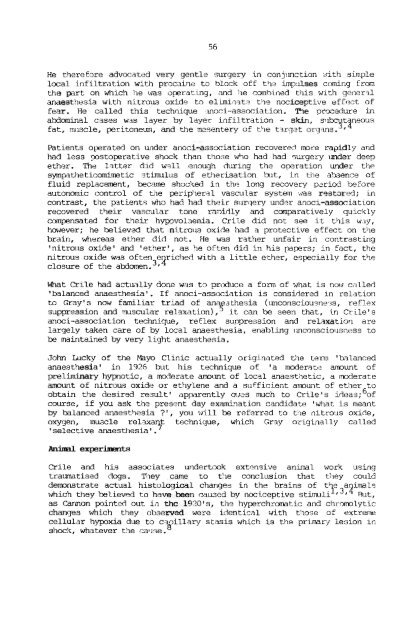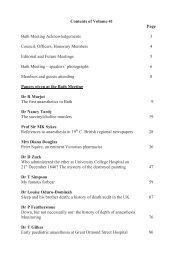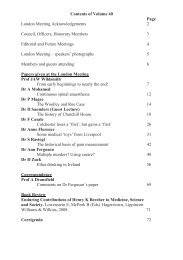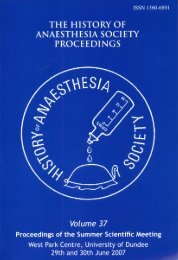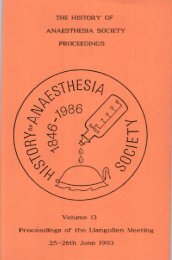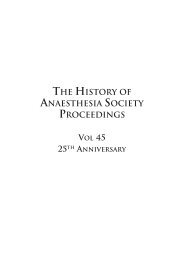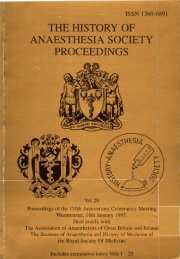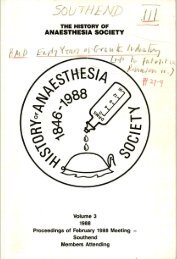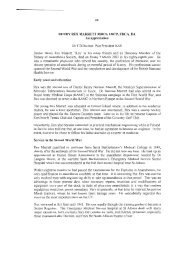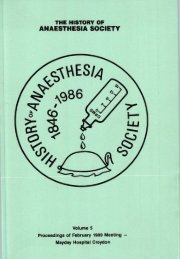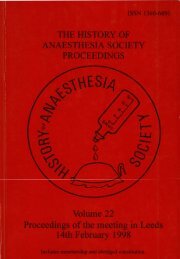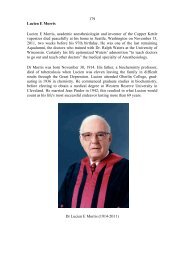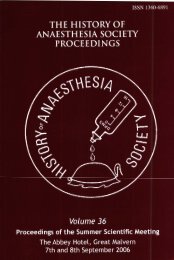Volume 9b - History of Anaesthesia Society
Volume 9b - History of Anaesthesia Society
Volume 9b - History of Anaesthesia Society
You also want an ePaper? Increase the reach of your titles
YUMPU automatically turns print PDFs into web optimized ePapers that Google loves.
He thereEore advocated very gentle surgery in conjlmction xith simple<br />
local infiltration with procaine to block <strong>of</strong>f the impdses coming from<br />
the part on which he was operating, and he combined this with generql<br />
anaesthesia with nitro~ oxide to elimimt? the nociceptive effect <strong>of</strong><br />
fear. He called this technique moci-association.<br />
The prxedure in<br />
aWcminal cases was layer by layer infiltration - skin,<br />
s1'9f2ne0us<br />
fat, rnilscle, peritoneum, and the mzsentery <strong>of</strong> the t3rgt orgms.<br />
Patients operatd on under anoci-association recovered more rapidly and<br />
had less ~stoprative shock than those ho had had surgery under deep<br />
ether. The latter did W-11 enough during the opration under the<br />
symp~thetico~tic stimulus <strong>of</strong> etherisation ht, in the a5sence <strong>of</strong><br />
fluid replacenent, became shocked in thr? long recovery p2rid before<br />
autonomic control <strong>of</strong> Cqe perip~eral vascular system ;.ms restsred; in<br />
contrast, tine ptients who had had their suirqery under anoci-association<br />
recovered their vascular tone mfiidly and camparatively quickly<br />
compensated for their hypovolaemia. Crile did not see it this w3y,<br />
however; he believed that nitrous oxide had a protective effect on the<br />
brain, whereas ether did not. He was rather unfair in contrasting<br />
'nitro~ls oxide1 and 'ether', as he <strong>of</strong>ten did in his papers; in fact, the<br />
nitrous oxide was <strong>of</strong>ten e riched with a little e,ther, especially for the<br />
closure <strong>of</strong> the a ~ r n n . ~ ~ ~<br />
What Crile had act~mlly done was to prcduce a form <strong>of</strong> what is now called<br />
'%lanced anaesthesia'. If anoci-association is considered in relation<br />
to Gray's now familiar triad <strong>of</strong> an< 3thesi.a (unconsciousness, reflex<br />
suppression and muscular relsxation) it can be seen that, in Cri.le9s<br />
anoci-association technique, reflex su.npression and relaxation are<br />
largely taken care <strong>of</strong> by local anaesthesia, enabling ~mmnsciousness to<br />
be maintained by very light anaesthesia.<br />
John Lucky <strong>of</strong> the myo Clinic actually originated the term 'tnlanced<br />
anaesthesia' in 1936 but his technique <strong>of</strong> 'a moderate amount <strong>of</strong><br />
preliminary hypnotic, a morlerate amount <strong>of</strong> local anaesthetic, a derate<br />
amount <strong>of</strong> nitrow oxide or ethylene and a sufficient anount <strong>of</strong> ether to<br />
obtain the desired result1 apparently owas much to Crilels ideas;=<strong>of</strong><br />
course, if you ask the present day examiqation candidate 'what is meant<br />
by balanced anaesthesia ?', you \rill be referrad to tne nitro:ls oxide,<br />
oxygen, muacle relay, technique, which Gr2y originally called<br />
'selective anaesthesia .<br />
Crile and his assxiates undertook extensive animal work using<br />
trawtised dogs. They came to tile conclusion that they could<br />
demonstrate actual histoloqical changes in the brains <strong>of</strong> t e a imls<br />
which they believed to have been caused by nociceptive stinuli l 3 0 1 Bit,<br />
as rmon pointed out in thc 19201s, the hyperchrornatic and chrmlytic<br />
changes which they observed were identical with t%ose <strong>of</strong> extreme<br />
cellular hypxia due to c?oillary stasis which is the primary lesion in<br />
shoc!c, whatever the callse .'


